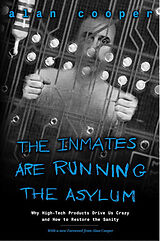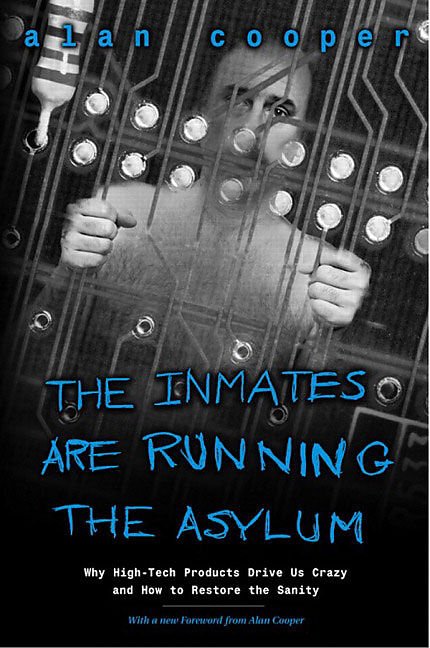Inmates Are Running the Asylum, The: Why High Tech Products Drive Us Crazy and How to Restore the Sanity
Einband:
Kartonierter Einband
EAN:
9780672326141
Untertitel:
Why High-Tech Products Drive US Crazy and How to Restore the Sanity
Genre:
Allgemein & Lexika
Autor:
Alan Cooper
Herausgeber:
Pearson Academic
Auflage:
2. Auflage
Anzahl Seiten:
288
Erscheinungsdatum:
11.03.2004
ISBN:
978-0-672-32614-1
Imagine, at a terrifyingly aggressive rate, everything you regularly use is being equipped with computer technology. Think about your phone, cameras, cars - everything - being automated and programmed by people who in their rush to accept the many benefits of the silicon chip, have abdicated their responsibility to make these products easy to use. "The Inmates are Running the Asylum" argues that, despite appearances, business executives are simply not the ones in control of the high-tech industry. They have inadvertently put programmers and engineers in charge, leading to products and processes that waste money, squander customer loyalty, and erode competitive advantage. Business executives have let the inmates run the asylum! In his book "The Inmates Are Running the Asylum" Alan Cooper calls for revolution - we need technology to work in the same way average people think - we need to restore the sanity. He offers a provocative, insightful and entertaining explanation of how talented people continuously design bad software-based products. More importantly, he uses his own work with companies big and small to show how to harness those talents to create products that will both thrill their users and grow the bottom line.
Alan Cooper calls for a Software Revolution - his best-selling book now in trade paperback with new foreword and afterword.
Autorentext
As a software inventor in the mid-70s, Alan Cooper got it into his head that there must be a better approach to software construction. This new approach would free users from annoying, difficult and inappropriate software behavior by applying a design and engineering process that focuses on the user first and silicon second. Using this process, engineering teams could build better products faster by doing it right the first time. His determination paid off. In 1990 he founded Cooper, a technology product design firm. Today, Cooper's innovative approach to software design is recognized as an industry standard. Over a decade after Cooper opened its doors for business, the San Francisco firm has provided innovative, user-focused solutions for companies such as Abbott Laboratories, Align Technologies, Discover Financial Services, Dolby, Ericsson, Fujitsu, Fujitsu Softek, Hewlett Packard, Informatica, IBM, Logitech, Merck-Medco, Microsoft, Overture, SAP, SHS Healthcare, Sony, Sun Microsystems, the Toro Company, Varian and VISA. The Cooper team offers training courses for the Goal-Directed® interaction design tools they have invented and perfected over the years, including the revolutionary technique for modeling and simulating users called personas, first introduced to the public in 1999 via the first edition of The Inmates. In 1994, Bill Gates presented Alan with a Windows Pioneer Award for his invention of the visual programming concept behind Visual Basic, and in 1998 Alan received the prestigious Software Visionary Award from the Software Developer's Forum. Alan introduced a taxonomy for software design in 1995 with his best-selling first book, About Face: The Essentials of User Interface Design. Alan and co-author Robert Reimann published a significantly revised edition, About Face: The Essentials of Interaction Design, in 2003. Alan's wife, Susan Cooper, is President and CEO of Cooper. They have two teenage sons, Scott and Marty, neither of whom is a nerd. In addition to software design, Alan is passionate about general aviation, urban planning, architecture, motor scooters, cooking, model trains and disc golf, among other things. Please send him email at inmates@cooper.com or visit Cooper's Web site at http://www.cooper.com.
Inhalt
Foreword.
I. COMPUTER OBLITERACY. 1. Riddles for the Information Age.
What Do You Get When You Cross a Computer with an Airplane? What Do You Get When You Cross a Computer with a Camera? What Do You Get When You Cross a Computer with an Alarm Clock? What Do You Get When You Cross a Computer with a Car? What Do You Get When You Cross a Computer with a Bank? Computers Make It Easy to Get into Trouble. Commercial Software Suffers, Too. What Do You Get When You Cross a Computer with a Warship? Techno-Rage. An Industry in Denial. The Origins of This Book. 2. Cognitive Friction.
Behavior Unconnected to Physical Forces. Design Is a Big Word. The Relationship Between Programmers and Designers. Most Software Is Designed by Accident. "Interaction" Versus "Interface" Design. Why Software-Based Products Are Different. The Dancing Bear. The Cost of Features. Apologists and Survivors. How We React to Cognitive Friction. The Democratization of Consumer Power. Blaming the User. Software Apartheid. II. IT COSTS YOU BIG TIME. 3. Wasting Money.
Deadline Management. What Does "Done" Look Like? Parkinson's Law. The Product That Never Ships. Shipping Late Doesn't Hurt. Feature-List Bargaining. Programmers Are in Control. Features Are Not Necessarily Good. Iteration and the Myth of the Unpredictable Market. The Hidden Costs of Bad Software. The Only Thing More Expensive Than Writing Software Is Writing Bad Software. Opportunity Cost. The Cost of Prototyping. 4. The Dancing Bear.
If It Were a Problem, Wouldn't It Have Been Solved by Now? Consumer Electronics Victim. How Email Programs Fail. How Scheduling Programs Fail. How Calendar Software Fails. Mass Web Hysteria. What's Wrong with Software? Software Forgets. Software Is Lazy. Software Is Parsimonious with Information. Software Is Inflexible. Software Blames Users. Software Won't Take Responsibility. 5. Customer Disloyalty.
Desirability. A Comparison. Time to Market. III. EATING SOUP WITH A FORK. 6. The Inmates Are Running the Asylum.
Driving from the Backseat. Hatching a Catastrophe. Computers Versus Humans. Teaching Dogs to Be Cats. 7. Homo Logicus.
The Jetway Test. The Psychology of Computer Programmers. Programmers Trade Simplicity for Control. Programmers Exchange Success for Understanding. Programmers Focus on What Is Possible to the Exclusion of What Is Probable. Programmers Act Like Jocks. 8. An Obsolete Culture.
The Culture of Programming. Reusing Code. The Common Culture. Programming Culture at Microsoft. Cultural Isolation. Skin in the Game. Scarcity Thinking. The Process Is Dehumanizing, Not the Technology. IV. INTERACTION DESIGN IS GOOD BUSINESS. 9. Designing for Pleasure.
Personas. Design for Just One Person. The Roll-Aboard Suitcase and Sticky Notes. The Elastic User. Be Specific. Hypothetical. Precision, Not Accuracy. A Realistic Look at Skill Levels. Personas End Feature Debates. Both Designers and Programmers Need Personas. It's a User Persona, Not a Buyer Persona. The Cast of Characters. Primary Personas. Case Study: Sony Trans Com's P@ssport. The Conventional Solution. Personas. Designing for Clevis.

Leider konnten wir für diesen Artikel keine Preise ermitteln ...
billigbuch.ch sucht jetzt für Sie die besten Angebote ...
Die aktuellen Verkaufspreise von 6 Onlineshops werden in Realtime abgefragt.
Sie können das gewünschte Produkt anschliessend direkt beim Anbieter Ihrer Wahl bestellen.
Loading...
Die aktuellen Verkaufspreise von 6 Onlineshops werden in Realtime abgefragt.
Sie können das gewünschte Produkt anschliessend direkt beim Anbieter Ihrer Wahl bestellen.
| # | Onlineshop | Preis CHF | Versand CHF | Total CHF | ||
|---|---|---|---|---|---|---|
| 1 | Seller | 0.00 | 0.00 | 0.00 |
